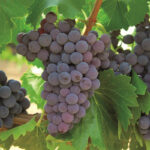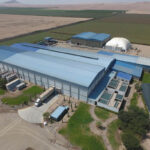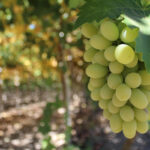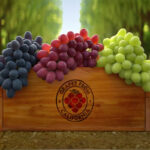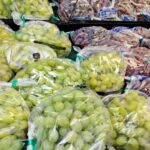Five lessons from a climatic catastrophe for the table grape industry

The following article was written by Martín Silva Armanet, agronomist for PUC and Paso Pehuenche Consulting and member of Chile's UVANOVA.
The three-day-long heavy rainfalls followed by at least two weeks of abnormally wet weather seen at the end of January and beginning of February, created the worst possible scenario for table grapes, given the event’s timing.
Table grapes were in the period between veraison, or pint, and harvest, during which the earliest varieties had begun to be harvested while the later ones were still increasing their sugar content.
The presence of free water by itself, in this phenological state of the host, in this case, the grape, creates an ideal environment for rot to develop, especially the types brought on by the Botrytis cinerea fungus. However, the damage caused by the rain, which becomes more severe as the amount of falling water increases, opens the gateway to infection with other fungi that lead to the disease known as Acid Rot.
As previously mentioned, the heavier the falling water, and the higher the fruit’s sugar content, the higher the incidence of cracks. A difference was seen in terms of damage between varieties, but a pattern could not always be identified due to a combination of various factors, which will be discussed later.
We cannot manage sugar levels when an event like this occurs, given that we do not know exactly when it happens, but if we increase the fruit’s sugar content, this is undoubtedly a factor to take into consideration.
Undoubtedly, the flavor of the grape improves with higher sugar content, but the ripening of the fruit for prolonged periods in the orchard can negatively affect its future quality.
Fortunately, the climate began to normalize as of February 20 and with this, the rotting stabilized. The affected fruit remained in that state, but the unstoppable advance of rot on the orchard level stabilized.
There is no fungicide superior to climate since Botrytis, in particular, is a disease dependant on climatic conditions. If these conditions are favorable for its development, even the best fungicides are insufficient at the field level, and while the conditions for the development of the disease persist, steps can only be taken to ensure that the damage is of a lesser degree.
As such, after touring orchards throughout the month of February, at least five lessons were learned that may be useful in future table grape production management.
The Five Lessons
Ventilation
The more ventilated vines were less affected. This has always been known and there are works, for example, by the well-remembered master Doug Gubler showing that ventilation is as important as the best fungicide and that even a good fungicide will not be more than50 percent effective against Botrytis without proper ventilation. Gubler was adamant on this point.
The vine must be ventilated, Jim Marois and Jenny Broome likewise argued. When they developed a predictive model of Botrytis, they demonstrated that with adequate wind circulation the mycelium was not able to colonize an adjacent fruit.
Both the vines and the gable formation must be adequately ventilated, allowing for the entry of light, and especially wind. Exposure to light will also make the grapes develop a better cuticle that is more resistant to infection. Therefore, in future operations, we must insist that our vines or gables be subjected to intense canopy management, to ensure better fruit quality.
Linear Formation in "H": Ventilated grills
Loose Bunches
It is also generally known that a tight bunch of grapes tends to rot more, as this tightness not only damages the grapes but is also impedes air circulation and the entry of agrochemicals.
At the same time, when the bunches are tight, water remains inside them for longer, prolonging the conditions favorable to the development of rot. Chileans fear the call for thinning, that is to say, having an insufficient number of grapes at the time of fruit set and consequently, bunches that are pale and light. In short, that the number of berries per hectare will be insufficient. However, if we ask ourselves the number of times we have suffered commercial damage from over-thinning, the truth is that we can remember very few instances in which it really occurred.
We have to be more aggressive because the cost and shortage of labor is also a current reality, aggravated by competition from other crops such as cherries, which capture the labor that could be thinning the bunches in their harvest. Therefore, we need to achieve better "chemical" or natural thinning in our bunches, so that they are looser and their arrangement is as simple and fast as possible so that we can adjust the number of bunches per hectare that we need to achieve a productive goal.
Any variety that requires costly thinning, or grows grapes easily, will be difficult to handle now and in the future. A solution needs to be found to these disadvantages or the grapes will not prosper. We must develop aggressive, simple, fast models of arrangement, tending to 1 or 2 levels and trying to eliminate the third. The arrangements should be evaluated favoring those that require fewer scissor cuts, achieving the stated objectives. There is neither sufficient human resources nor money to make "works of art", which today do not return a higher price. In short, loose bunches are in better condition.
Caliber
With the arrival of new varieties, size is no longer an issue. Potions and recipes aimed at achieving a higher caliber of fruit are less and less burdensome in the result since the new varieties are naturally larger grapes. However, we have a defect that needs to be corrected.
Normally, the price of the exported fruit tends to return better results for the higher caliber fruit. In reality, though, this does not always happen. We must look for the correct size that should have a better price today not promoting the search for larger and larger sizes with fictitious prices. There is a South African saying that “the bigger the berry, the bigger the problem”, and we must recognize that it is true. Medium sizes are no longer correct for the markets. That is, fruits with equatorial sizes less than 17.5 or 18 mm are no longer welcome. However, fruits with sizes greater than 25 mm gradually begin to complicate the condition of the fruit.
In many varieties, a correct size should be between 21 and 24 mm, avoiding exceeding this range. If that means not using Gibberellic Acid, what is the problem? There are varieties that can exceed 30 mm, and the truth is that eating a grape berry in two bites is a disadvantage and a discomfort. The grape has the grace of each grape being bite-sized. Do not make the mistake of transforming it into a plum, or a peach, since we would drip from our mouth and hands when we eat it. It is also scientifically proven that the overuse of growth regulators (Zoffoli et al) deteriorates the resistance of the cuticle, making the grape prone to the development of "hairline" cracks and potential subsequent rot. Orchards with smaller-sized fruit better withstand the effects of rain and weather so let's look for the correct size over the largest size.
Vigor
The most vigorous vines developed greater rotting, either because they had denser canopies (longer shoots, larger leaves), or because they contained higher nitrogen levels in their tissues. The relationship between nitrogen content and Botrytis development has been demonstrated since the fungus seeks out the nitrogen for its own development. Shade is more favorable to the fungus than light as it prefers a gloomy and less ventilated environment, as explained above.
More vigorous vines develop a greater susceptibility to mildew, a disease that seriously affects several new, generally vigorous, varieties. The damage from mildew to the cuticle causes them to lose elasticity. It is a source of particles and therefore leads to fungal infection, especially Acid Rot. We must avoid over vigor and cultivate more balanced vines.
Agrochemical Application Techniques
Differences were observed in barracks that can only be explained in terms of application quality. For example, between a ventilated gable and a well-ventilated vineyard, the difference was clearly in the distance between the nozzles and the target bunches. In Chile, producers consider merely making the application to be sufficient, but the quality of the application is decisive.
What percentage of our producers can ensure that their equipment is well-calibrated? Or that their operators know the RPM at which the power take-off must operate? Or at what Engine RPM is 540 RPM, which is normally the standard for tractor-mounted sprayer pumps, achieved at the power take-off? What catalog pressure should we give to the nozzles so that they produce the correct drop, avoiding unnecessary drifts and losses?
In short, even among agronomists and consultants, these issues are not fully handled despite the importance they entail. The best fungicide can fail due to poor application. I believe that there is a known world that is of the utmost importance but is currently being left to its own devices. Agrochemical applications must be done correctly, with the proper calibration so that agrochemicals act in the best possible manner.
Finally, independent of future adverse climatic events, moving towards the application of these lessons learned will permit us to obtain better quality fruit. For this reason, I venture to propose that in future operations, we do not forget the main lessons, (although there are many more), that the catastrophe of the 2020-21 season has given us.



















